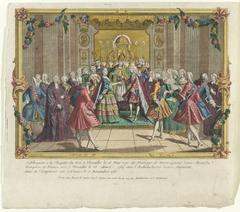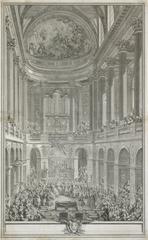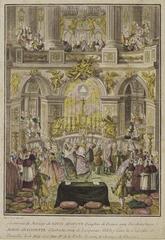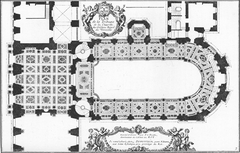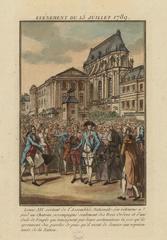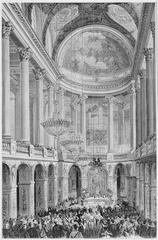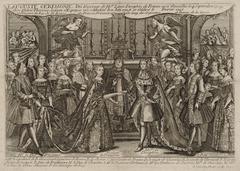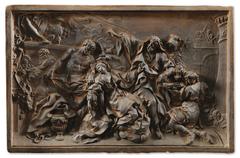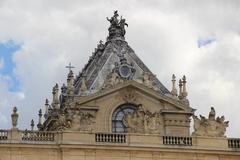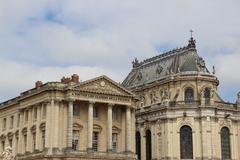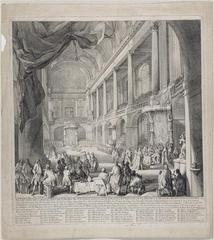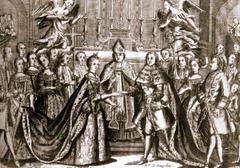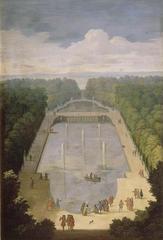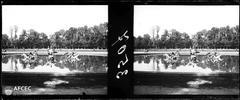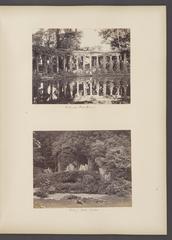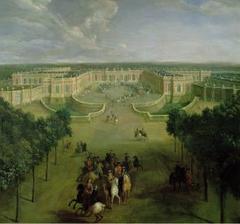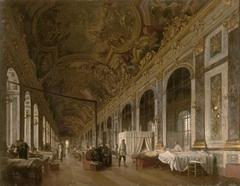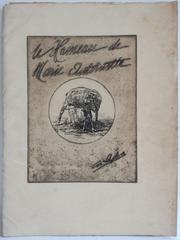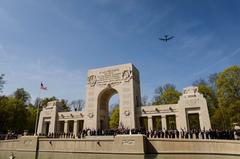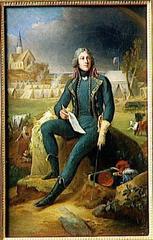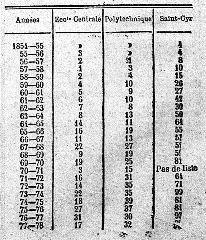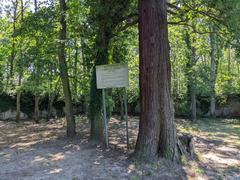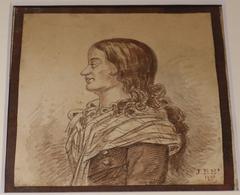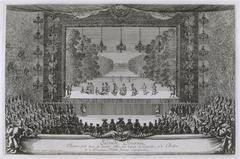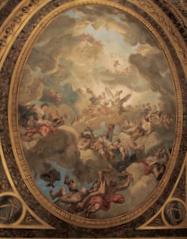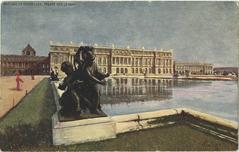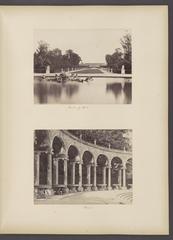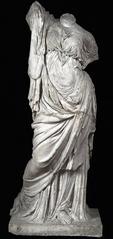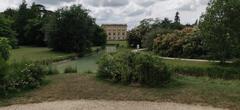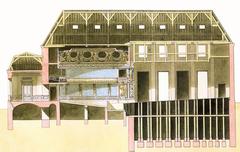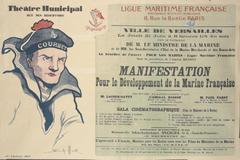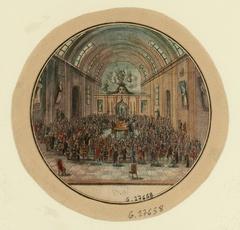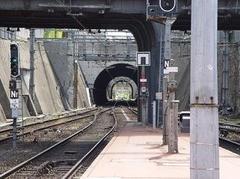
Visiting Hours, Tickets, and Travel Tips for Chapelle Royale de Versailles, Versailles, France
Date: 31/07/2024
Introduction
The Chapelle Royale de Versailles, an architectural marvel nestled within the grand Palace of Versailles, stands as a testament to the opulence and grandeur of the French Baroque period. Constructed between 1689 and 1710 under the reign of Louis XIV, this chapel not only embodies the religious devotion of the French monarchy but also serves as a symbol of the divine right of kings. The chapel’s towering height, intricate frescoes, and stunning stained glass windows reflect the artistic and cultural aspirations of the era. Visitors to the Chapelle Royale can explore its rich history through guided tours and immersive experiences, making it a must-visit for history enthusiasts and casual tourists alike. The chapel’s historical significance, combined with its architectural splendor, offers a unique glimpse into the life and times of the Sun King, reinforcing its status as a key attraction within the Palace of Versailles (Château de Versailles).
Table of Contents
- [Exploring the Chapelle Royale: History, Visiting Hours, and Tickets at Versailles](#exploring-the-chapelle-royale-history-visiting-hours-and-tickets-at-versaillesexploring-the-chapelle-royale-history-visiting-hours-and-tickets-at-versailles)
- [Early Chapels at Versailles](#early-chapels-at-versaillesearly-chapels-at-versailles)
- [The Third and Fourth Chapels](#the-third-and-fourth-chapelsthe-third-and-fourth-chapels)
- [Construction of the Fifth Chapel](#construction-of-the-fifth-chapelconstruction-of-the-fifth-chapel)
- [Architectural Significance](#architectural-significancearchitectural-significance)
- [Musical Heritage](#musical-heritagemusical-heritage)
- [Restoration Efforts](#restoration-effortsrestoration-efforts)
- [Visitor Experience](#visitor-experiencevisitor-experience)
- [Visiting Hours](#visiting-hoursvisiting-hours)
- [Tickets](#ticketstickets)
- [Travel Tips](#travel-tipstravel-tips)
- [Nearby Attractions](#nearby-attractionsnearby-attractions)
- [Accessibility](#accessibilityaccessibility)
- [FAQ](#faqfaq)
- [Cultural Insights](#cultural-insightscultural-insights)
- [Musical Heritage](#musical-heritagemusical-heritage-1)
- [Artistic Significance](#artistic-significanceartistic-significance)
- [Events and Activities](#events-and-activitiesevents-and-activities)
- [Religious Services](#religious-servicesreligious-services)
- [Special Exhibitions](#special-exhibitionsspecial-exhibitions)
- [Concerts and Performances](#concerts-and-performancesconcerts-and-performances)
- [Practical Information](#practical-informationpractical-information)
- [Transportation](#transportationtransportation)
- [Practical Tips](#practical-tipspractical-tips)
- [FAQ](#faqfaq-1)
- [Conclusion](#conclusionconclusion)
- [References](#referencesreferences)
Exploring the Chapelle Royale: History, Visiting Hours, and Tickets at Versailles
Early Chapels at Versailles
The Chapelle Royale de Versailles, located within the Palace of Versailles, is the fifth and final chapel built on the site. The evolution of these chapels reflects the architectural and cultural shifts that occurred during the reigns of Louis XIII and Louis XIV. The first chapel, constructed during the time of Louis XIII, was situated in a detached pavilion at the northeast of the château. This chapel followed the traditional two-story palatine model, which was common in France. However, it was demolished in 1665 to make way for the Grotte de Thétys (Wikipedia).
The second chapel was part of Louis XIV’s second building campaign (1669–1672) and was located in the Grand appartement de la reine. It served the royal family and court until 1678, when it was converted into the Salle des Gardes de la Reine (Wikipedia).
The Third and Fourth Chapels
The third chapel, built next to the new Salle des Gardes de la Reine, was short-lived. Louis XIV found it inconvenient for his needs and those of his court, leading to its conversion into the Grande Salles des Gardes de la Reine in 1682 (Wikipedia).
The fourth chapel was constructed with the Aile du Nord (North Wing) of the château, necessitating the destruction of the Grotte de Thétys. This chapel, completed in 1682, was used until 1710 and witnessed many significant events during the reign of Louis XIV. The Salon d’Hercule and the lower vestibule now occupy this site (Wikipedia).
Construction of the Fifth Chapel
The fifth and final chapel, known as the Chapelle Royale, was part of Louis XIV’s fourth and last building campaign (1699–1710). The construction began in 1689 but was halted due to the War of the League of Augsburg. Jules Hardouin-Mansart resumed the project in 1699 and continued until his death in 1708. His brother-in-law, Robert de Cotte, completed the chapel in 1710 (Wikipedia).
The Chapelle Royale stands out for its height, with the ridge of the roof reaching 40 meters, making it several dozen meters higher than the surrounding buildings. This architectural choice symbolized the divine right monarchy, with the chapel standing higher than the palace, a reminder of the source of Louis XIV’s temporal power (Château de Versailles).
Architectural Significance
The Chapelle Royale is a masterpiece of sacred architecture and an impressive showpiece of the arts of its time. The building’s overall design, large glass windows, and buttresses were inspired by Gothic architecture. The chapel was dedicated to Saint Louis, the patron saint of the king and an ancestor of the royal house, and included references to the Sainte-Chapelle of Paris, which he had founded (Château de Versailles).
Inside, the chapel features an uninterrupted vault with prominent frescoes, and free-standing columns that allow bright light to enter through large panes of clear glass—a luxury at the time. The interior elevation follows the usual format for Palatine chapels, with its layout on two floors, but its architecture with an imposing colonnade on the first floor was clearly inspired by antiquity (Château de Versailles).
Musical Heritage
Music played a significant role in the Chapelle Royale. The ceremony to bless the chapel included the inauguration of the organ by François Couperin. The organ, designed by Clicquot, is decorated with a relief of King David and faces the gallery where the royal family sat during mass. The chapel continues to host concerts, playing a large repertoire of sacred and secular music from its time and the present day, allowing the acoustics of this exceptional musical venue to resonate more than 300 years after its construction (Château de Versailles).
Restoration Efforts
The Chapelle Royale has undergone several restoration efforts to preserve its architectural integrity and historical significance. More than forty years after its last major restoration, the chapel required urgent intervention on the roof timbers, roof and decorative lead work, statues, and window frames and stained glass. These efforts ensure that the chapel remains an intact expression of the ambition of Louis XIV and his architect, providing Versailles with a chapel worthy of the greatest palace in Europe (Château de Versailles).
Visitor Experience
Visitors to the Chapelle Royale can explore its rich history and architectural splendor through guided tours and virtual visits. The chapel is part of the larger Palace of Versailles estate, which includes the Grand and Petit Trianon, the gardens, and the Gallery of Coaches. The palace is open from 9:00 am to 6:30 pm, with the estate of Trianon open from 12:00 pm to 6:30 pm. The gardens and park are open from 7:00 am to 8:30 pm (Château de Versailles).
Visiting Hours
The Chapelle Royale is open to visitors during the same hours as the Palace of Versailles, from 9:00 am to 6:30 pm. It is advisable to check the official website for any changes or special events that might affect visiting hours (Château de Versailles).
Tickets
Tickets for the Chapelle Royale and the Palace of Versailles can be purchased online or at the entrance. It is recommended to buy tickets in advance, especially during peak seasons. Various ticket options are available, including individual tickets, group tickets, and combined tickets that include access to the Trianon estate and other attractions (Château de Versailles).
Travel Tips
For those planning a visit, it is advisable to plan the visit strategically to avoid crowds, especially during the high season and on days of fountain shows. The palace is easily accessible from Paris, with a 35-minute train ride on RER Line C from central Paris to the Versailles-Rive Gauche station, followed by a ten-minute walk to the royal estate (The Tour Guy).
Nearby Attractions
In addition to the Chapelle Royale, visitors can explore other parts of the Palace of Versailles estate, including the Grand and Petit Trianon, the gardens, the Gallery of Coaches, and the Hall of Mirrors. Each attraction offers a unique glimpse into the opulence and history of the French monarchy.
Accessibility
The Palace of Versailles, including the Chapelle Royale, is committed to providing access to all visitors. The site offers various services to accommodate visitors with disabilities, including wheelchair access, adapted tours, and assistance for visitors with hearing and visual impairments (Château de Versailles).
FAQ
What are the visiting hours for the Chapelle Royale?
The Chapelle Royale is open from 9:00 am to 6:30 pm, in line with the Palace of Versailles’ visiting hours.
How much are tickets to the Palace of Versailles?
Ticket prices vary depending on the type of ticket and the areas you wish to visit. It is recommended to check the official website for the latest prices and to purchase tickets in advance.
Are there guided tours available for the Chapelle Royale?
Yes, guided tours are available and can be booked through the official Palace of Versailles website. Virtual tours are also offered for those who cannot visit in person.
Cultural Insights
Musical Heritage
The Chapelle Royale has a rich musical heritage, with its grand organ and acoustics making it an ideal venue for concerts and religious music. The chapel regularly hosts performances of Baroque music, often featuring works by composers such as Jean-Baptiste Lully and François Couperin, who were associated with the court of Louis XIV. These concerts provide a unique opportunity to experience the chapel’s exceptional acoustics and immerse oneself in the musical traditions of the French court (Château de Versailles).
Artistic Significance
The chapel is also notable for its artistic significance, housing numerous works of art that reflect the religious and political themes of the time. The frescoes, sculptures, and stained glass windows are masterpieces of Baroque art, showcasing the skill and creativity of the artists who worked on the chapel. The integration of art and architecture in the chapel’s design creates a harmonious and awe-inspiring space that continues to captivate visitors (Château de Versailles).
Events and Activities
Religious Services
While the Chapelle Royale is primarily a historical site, it still hosts occasional religious services, including masses and special ceremonies. These events are open to the public and provide a unique opportunity to experience the chapel in its original context as a place of worship. Check the official Versailles website for information on upcoming services and events (Château de Versailles).
Special Exhibitions
The chapel also hosts special exhibitions that explore various aspects of its history, architecture, and cultural significance. These exhibitions often include rare artifacts, documents, and artworks, providing deeper insights into the chapel’s role in the life of the French court. Visitors can check the official website for information on current and upcoming exhibitions (Château de Versailles).
Concerts and Performances
In addition to religious services, the Chapelle Royale is a popular venue for concerts and performances, particularly those featuring Baroque music. These events are held throughout the year and offer a unique opportunity to enjoy live music in a historic and acoustically superb setting. Tickets for these performances can be purchased online or at the palace ticket office (Château de Versailles).
Practical Information
Transportation
Versailles is located approximately 19 km (12 miles) west of Paris and is easily accessible by public transportation. The RER C train line connects Paris to Versailles Château Rive Gauche station, which is a short walk from the palace. During the Paris 2024 Olympic Games, free shuttles will be available from Versailles train stations to the Olympic site (Earth Trekkers).
Practical Tips
- Transportation: The Palace of Versailles is easily accessible by train from Paris. Take the RER C line to the Versailles Château-Rive Gauche station, which is a short walk from the palace.
- Dress Comfortably: Wear comfortable shoes as there is a lot of walking involved when touring the palace and its extensive gardens.
- Stay Hydrated: Bring a water bottle, especially during the summer months, as the grounds can be quite warm.
FAQ
Q: What are the visiting hours for the Chapelle Royale de Versailles?
A: The Chapelle Royale is open from 9:00 am to 6:30 pm, in line with the Palace of Versailles’ visiting hours.
Q: How much are tickets to the Palace of Versailles?
A: The “Passport” ticket costs 32 EUR and includes access to the chapel, palace, gardens, and other attractions. A ticket for the palace alone is 21 EUR.
Q: Is the Chapelle Royale accessible to visitors with disabilities?
A: Yes, the chapel is accessible to visitors with disabilities. Free admission is available for persons with disabilities and one accompanying person, with proper ID required.
Q: What is the best time to visit the Chapelle Royale?
A: To avoid the largest crowds, it is advisable to visit during the shoulder seasons of late spring or early fall. Weekdays are generally less crowded than weekends.
Q: Are there guided tours available?
A: Yes, guided tours are available and often include access to areas not open to the general public. Free audio guides are also available at the palace, or you can download the official Versailles app for a self-guided tour.
Conclusion
In conclusion, the Chapelle Royale de Versailles is not just an architectural gem but also a vital piece of French history and culture. From its early chapels to the magnificent structure completed under Louis XIV, the chapel stands as a testament to the artistic and religious fervor of its time. Visitors can immerse themselves in the chapel’s rich musical heritage and marvel at its architectural features, while guided tours and special exhibitions provide deeper insights into its historical context. With practical tips on ticketing, visiting hours, and travel, this guide ensures a memorable and enriching visit to one of Versailles’ most remarkable sites. The Chapelle Royale continues to captivate and inspire, offering a profound connection to the grandeur and spiritual life of the French monarchy (Nomadic Matt; Earth Trekkers).
References
- Château de Versailles. Restoration of the Royal Chapel. Retrieved from https://en.chateauversailles.fr/news/life-estate/restoration-royal-chapel/royal-chapel
- Wikipedia. Chapels of Versailles. Retrieved from https://en.wikipedia.org/wiki/Chapels_of_Versailles
- Nomadic Matt. The Palace of Versailles. Retrieved from https://www.nomadicmatt.com/travel-blogs/the-palace-of-versailles/
- Earth Trekkers. How to Visit Versailles. Retrieved from https://www.earthtrekkers.com/how-to-visit-versailles/
